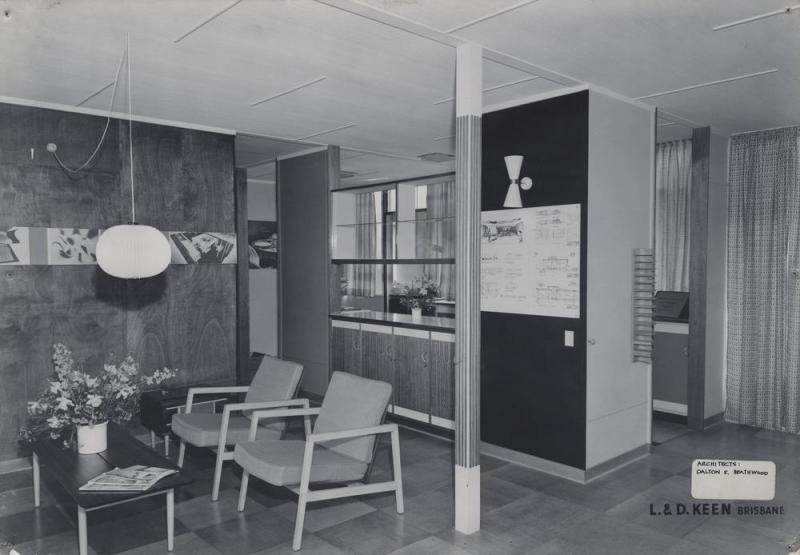Addresses
Type of place
House
Period
Postwar 1945-1960
Style
Queenslander
Addresses
Type of place
House
Period
Postwar 1945-1960
Style
Queenslander
This innovative plywood house was designed by architect Peter Heathwood in the late 1950s. It embodies a departure from the traditional Queenslander in its building materials and form and displays the sensitivity to climate and landscape that was promulgated in this period. It won the 1958 Plywood House Competition and was displayed at the Brisbane Exhibition from 1958 until 1963 before being moved to this site at The Gap.
Also known as
Plywood Exhibition House
Lot plan
L89_RP95351
Key dates
Local Heritage Place Since —
Date of Citation —
Construction
Roof: Corrugated iron;Walls: Timber
People/associations
Dalton and Heathwood (Architect)Criterion for listing
(F) Technical; (H) Historical associationInteractive mapping
Also known as
Plywood Exhibition House
Lot plan
L89_RP95351
Key dates
Local Heritage Place Since —
Date of Citation —
Construction
Roof: Corrugated iron;Walls: Timber
People/associations
Dalton and Heathwood (Architect)Criterion for listing
(F) Technical; (H) Historical associationInteractive mapping
History
In the 1950s and 1960s in Queensland the wartime austerity, restrictions and shortages slowly gave way to affluence and a sense of optimism. Architects, influenced by modern international styles benefited from the postwar conditions as immigration and a baby boom contributed to the rapidly developing urban sprawl in Brisbane. Much of this development consisted of ‘fibro’ and timber bungalows as the traditional verandahed Queenslander fell victim to shortages of building materials and a perception of being ‘old fashioned’. Architects, adopting international and interstate trends, developed a new awareness of the importance of taking account of climate and landscape in the design of new buildings. Queensland architects, like Heathwood, John Dalton and Theo Thynne and Associates, were searching for “an architecture with an identifiable Queensland flavour” and incorporated “traditional devices, such as roof ventilation, screening and verandahs … but did not … imitate the forms of the traditional house."1
Peter Heathwood, then a newly registered architect, designed this ‘Plywood House’ in 1958 for the Plywood House Competition. With working drawings prepared by fellow architect John Dalton, the design won the competition. The house was constructed and displayed at the Brisbane Exhibition for a number of years and in 1963 was moved to this site in the bushland suburb of The Gap.
The practice of Heathwood and Dalton was formed in 1957. According to Hampson “It was an energetic practice that produced many innovative designs that received Australia wide recognition.”1 They designed a number of award-winning homes, including the (now demolished) Speare Residence at Indooroopilly. Peter Heathwood went on to establish his own practice and his work influenced a number of student architects in the ‘sixties and ‘seventies.
Statement of significance
Relevant assessment criteria
This is a place of local heritage significance and meets one or more of the local heritage criteria under the Heritage planning scheme policy of the Brisbane City Plan 2014. It is significant because:
Supporting images

L. & D. Keen Pty. Ltd. (photographers) for the Royal Australian Institute of Architects (Queensland Chapter),
'Interior of a plywood exhibition house on display at the Brisbane Exhibition Ground at Bowen Hills, Queensland, 1958',
John Oxley Library, State Library of Queensland.
The house, designed by Peter Heathwood to exhibit the possibilities of plywood both externally and internally, was the winning entry in a competition held by the Queensland Plywood Board at the Brisbane Exhibition Grounds in 1958. The prize money enabled Heathwood and John Dalton to start their architectural practice. The house was purchased by Heathwood’s sister and removed to the Brisbane suburb of The Gap in 1963.
[Information taken from: Robert Riddel, Significant Queensland 20th century architecture: a report, retrieved 2 December 2013, from http://www.architecture.com.au/docs/default-source/qld-notable-buildings/20c_arch_final_report_for_review-%281%29.pdf?sfvrsn=2)]
(Description supplied with image)
References
-
Avery, P., Dennis P., Whitman P., eds. Cool: The 60s Brisbane House, QUT Brisbane, 2004, p41
-
Avery, P., Dennis P., Whitman P., eds. Cool: The 60s Brisbane House, QUT Brisbane, 2004, p49
-
Avery, P., Dennis P., Whitman P., eds. Cool: The 60s Brisbane House, QUT Brisbane, 2004
-
Brisbane City Council. Building Card, 23 Karowara Street, The Gap
-
Dennis, Peta “Innovative Architecture for Living: Brisbane architect-designed houses of the 1960s”, BA (Arch), QUT, 1999, p. 17.
-
Hampson, Alice L. T. “The Fifties in Queensland: Why Not? Why?”, BA (Arch), UQ, 2000
Citation prepared by — Brisbane City Council (page revised June 2022)